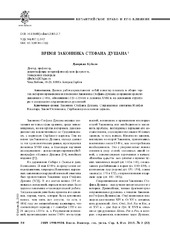Приказ основних података о документу
The era of Dusan's code
| dc.creator | Bubalo, Đorđe | |
| dc.date.accessioned | 2021-10-12T12:07:38Z | |
| dc.date.available | 2021-10-12T12:07:38Z | |
| dc.date.issued | 2015 | |
| dc.identifier.issn | 1998-9938 | |
| dc.identifier.uri | http://reff.f.bg.ac.rs/handle/123456789/1974 | |
| dc.description.abstract | Drawing on the structure and contents of the extant manuscripts of the Dusan's Code, this paper attempts to roughly outline the history of its application and changes from its promulgation in 1349 and revision in 1353- 1354 to the end of the 18th century. The scarce evidence about the application of the Code has been preserved in some charters issued by the emperors Dusan and Uros, but since the 15th century the only evidence about its application is found in its new copies or the changes in its structure and in the phrasing of certain stipulations. The producing of copies similar to the original version continued simultaneously with the revisions of Dusan's Code, with all sharing a single trait: the coalescence of Dusan's Code with its codicological environment, whose first and fixed layer included the Abbreviated Syntagma of Matthew Blastares and so called Justinian's Code. Along with these, other ecclesiasticallegal compositions were also copied, which suggest that the extant copies of Dusan's Code were used in ecclesiastical courts or for the clergy's everyday service needs. The signs which suggest that the Code was gradually adapted to suit different legal and social conditions are: the exclusion of stipulations which were no longer up-to-date; a new systematization of stipulations according to the subject matter; changes in penalties and sanctions; amendments and clarifications of some stipulations; and the modernization of the document's language and legal terms. No earlier than the second half of the 17th century, a separate recension of Dusan's Code was created in order to facilitate the adaptation and use of the Code's legal material for the regulation of those legal relations which the Serbian ecclesiastical hierarchy or the local self-governing authorities had kept in their jurisdiction under foreign rule. The majority of the copies of this new, younger recension was created and enacted in the circle of the Serbian ecclesiastical hierarchy and the subjects of the Habsburg Monarchy after the Great Exodus. Not only did the Code provide positive legal material, but its mere existence and authority also helped the efforts of the Serbian hierarchy in the Habsburg Monarchy to emphasize the tradition of Serbian statehood, as well as its tendencies towards a renewal of state independence. | en |
| dc.publisher | Volgograd State Univ, Volgograd | |
| dc.rights | openAccess | |
| dc.rights.uri | https://creativecommons.org/licenses/by/4.0/ | |
| dc.source | Volgogradskii Gosudarstvennyi Universitet-Vestnik-Seriya 4-Istoriya Regionovedenie Mezhdunarodnye Ot | |
| dc.subject | Serbian Orthodox Church | en |
| dc.subject | Justinian's Code | en |
| dc.subject | Dusan's Code | en |
| dc.subject | Abbreviated Syntagma of Matthew Blastares | en |
| dc.title | The era of Dusan's code | en |
| dc.type | article | |
| dc.rights.license | BY | |
| dc.citation.epage | 78 | |
| dc.citation.issue | 3 | |
| dc.citation.other | 20(3): 58-78 | |
| dc.citation.spage | 58 | |
| dc.citation.volume | 20 | |
| dc.identifier.doi | 10.15688/jvolsu4.2015.3.7 | |
| dc.identifier.fulltext | http://reff.f.bg.ac.rs/bitstream/id/10276/Bubalo.pdf | |
| dc.identifier.wos | 000217281300008 | |
| dc.type.version | publishedVersion |

